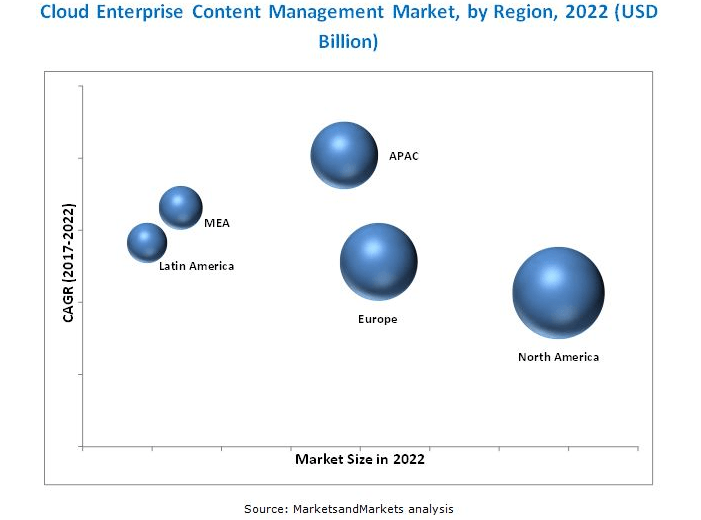Digital Enterprises Get Their Head into the Cloud
According to the Economist, while content is doubling every 90 days, 80 percent of content  used by knowledge workers for core revenue generation activities is unstructured. This explosive growth of unstructured content is becoming a big challenge for many organizations, especially for enterprises. Therefore, the number of enterprises that leverage the power of cloud computing is on the rise. In fact, the cloud Enterprise Content Management (ECM) market size is expected to grow from USD 9.77 Billion in 2017 to USD 34.42 Billion by 2022, at a Compound Annual Growth Rate (CAGR) of 28.6%, reports MarketsandMarkets.
used by knowledge workers for core revenue generation activities is unstructured. This explosive growth of unstructured content is becoming a big challenge for many organizations, especially for enterprises. Therefore, the number of enterprises that leverage the power of cloud computing is on the rise. In fact, the cloud Enterprise Content Management (ECM) market size is expected to grow from USD 9.77 Billion in 2017 to USD 34.42 Billion by 2022, at a Compound Annual Growth Rate (CAGR) of 28.6%, reports MarketsandMarkets.
Besides the growth in the digital content across enterprises, easier access from remote end-points, need for protection of enterprise data against disaster, and the need for regulatory compliances are cited in the report as the other primary drivers behind the shift from the legacy ECM solutions to the cloud. As a matter of the fact, last month, Forrester also published The Forrester Wave: Enterprise Content Management — Business Content Services, Q2 2017, and one of the key takeaways from the report is that there is an alarming situation for longtime ECM providers because new entrants are closing deals with cloud-native content platforms or modern architectures that support the delivery of flexible, granular, purposeful applications. As a result, longtime ECM vendors’ complex, highly customized on-premises deployment options lead enterprises to consider new cloud-native content platforms. Gartner also cited in its annual report, The Magic Quadrant for Enterprise Content Management, that by 2018, the Stamford, Conn.-based research firm expects half of the enterprises to manage content on hybrid systems (cloud/on-premise) and half of the big-name ECM vendors to re-architect their software to be cloud-based.
Now that we understand that the growth of the market has been acknowledged by the major market research firms, let’s discuss the primary business outcomes for organizations that reap the benefits of moving from the legacy ECM solutions to the cloud-based content management services:
Maximizing the Value of Unstructured Content
Approximately 60% of the average employee’s day is spent working on an organization’s records and documents. According to Forbes Insight, 95% of organizations agree that strong information management is critical for business success. Therefore, the document and content management solutions are considered as the largest components of the enterprise content management market. The sheer volume of documents and content generated in an enterprise on a daily basis has driven the need to manage and store the generated data as well as to maintain metadata files. With on-premise solutions, content is managed but not necessarily maximized, but with a cloud-based ECM, content is delivered in line with process creating business value.
Another important advantage of a cloud-based ECM, as far as content management goes, is that metadata is pre-populated based on corporate and process definition, whereas it is in the hands of the users with legacy ECM solutions, meaning that unstructured information turns into structured information that can be sorted, searchable, or referenced.
Global Accessibility
At a very simplistic level, years ago, companies implemented the legacy ECM solutions to put their content online so it can be more accessible than a piece of paper. Today, with the cloud deployment, content is even more accessible for companies with distributed workforces from multiple time zones that need anywhere, anytime access to information. This is also important to employee engagement as organizations can enable their employees to stay on top of what’s happening in the workplace with intuitive collaboration technologies through their devices, instead of burning them out with a myriad amount of business travel per year, so they wouldn’t have to sacrifice work-life balance. In fact, the study shows that 81 percent of engaged employees intend to stay with their current employers which leads to 22 percent higher profits for the company.
This type of collaboration doesn’t only provide work-life balance and a positive impact on employee engagement but also reduces the cost and lost productivity associated with business travels.
Increased Productivity
Now that the information and data are more accessible, and the technology removed the boundaries between countries, through a cloud-based ECM, employees can better collaborate with each other as well as their clients as they can work on the same document from anywhere and via multiple devices. Unfortunately, the value of having a strong collaborative environment is often underestimated because a cloud-based ECM solution not only increases the level of collaboration but also helps organizations maximize their investment in internal and external communications. In fact, although 40% of organizations have portions of their budgets dedicated to benefits communication, only 19% feel that their associates have a high level of understanding of benefits-related info, according to an IFEBP survey.
Another reason for the adoption of a cloud-based ECM solution is that by the year 2020, it is estimated that millennials will form 75% of the global workforce, and this new generation is not known for their high tolerance of cumbersome and lacking features, as they are used to working with fast technology solutions through their own personal devices. Therefore, the next versions of ECM solutions will need to be able to drive productivity and enable employees to collaborate and share content smoothly, with both personal and corporate technology devices in a secure manner. In other words, the legacy ECM solutions are becoming obsolete and irrelevant. On the other hand, the use of SaaS ECM solutions are rising, and more and more businesses have started shifting to it.
Cost Reduction
Typically, deploying an ECM solution on-premises requires a heavy investment in network infrastructure and physical assets. Moving ECM to the cloud, on the other hand, frees organizations from up-front IT costs and maintenance expenses associated with on-premises technologies. Besides these, businesses can leverage their IT resources to strategically innovate more instead of focusing on regular costly operations like patching, monitoring, and time-consuming upgrading. On-premises ECM applications can cost $1 million or more, with $200,000 or more being invested in hardware alone.
“Organizations often see cloud deployments as a primary means of reducing their ECM TCO [total cost of ownership], meaning ECM leaders are missing out on opportunities to gain agility and modernize user experiences,” stated Gartner in its report, entitled Strategize to Reap the Benefits of Moving Content Management Applications to the Cloud.
Security
Because the data is no longer on-premises, there is still a misconception about the security implications of the cloud, but ironically, for many reasons, data can actually be more secure, particularly compared with a shared file service. Alfresco Software, for example, is one of the enterprise content management (ECM) providers that announced early access availability of its platform as a single-tenant managed service hosted in an Amazon Web Services Virtual Private Cloud last year. John Newton, Co-founder, CTO and Chairman of Alfresco Software, explained the motivation behind their new offering: “As security demands increase at the same time that data center costs rise, customers are looking for virtual private clouds to reduce costs and better secure critical business information. Large and regulated companies want airtight control of their mission-critical files, which can be over half the files in an organization, but without the hassle of huge data centers.”
Process Integration
Today, organizations need to automate horizontal processes like accounts payable, invoice processing, case management, contracts management or correspondence management as well as ensure that their finance department can communicate seamlessly with HR, or their production departments should directly interact with the supply chain in real time. To meet this ever-increasing demand for connectivity across company borders, cloud-based ECM solutions are now architected to be extended into the processes and systems to provide the same consistent control and governance on data generated. Everything from inventory reports to service contracts to customer correspondence can all be connected, collected, and presented, so authorized employees would know the whole story on any initiative or case to meet their target audience expectations at the edge.
To put the importance of integration capabilities into perspective; Gartner has made some changes to the inclusion criteria that have resulted in a number of vendors included having dropped from 20 in 2015 to 15 in 2016 in its latest Magic Quadrant for Enterprise Content Management report, and integration is one of the new criteria. According to the new rule, the vendor's main ECM product must integrate with at least five business applications (ERP, CRM, HR, productivity suite or other business process applications) either natively or through connectors or add-on components.
Market Overview by Region
If we circle back to the report by MarketsandMarkets mentioned in the opening paragraph, it is cited that North America is expected to hold the largest market share and dominate the cloud ECM market from 2017 to 2022 as the market has been extremely responsive when it comes to adopting the latest technological advancements such as integration technologies with cloud and mobile technologies within ECM solutions. The main factors behind this responsiveness are the rapid growth of e-commerce and the demand for better control and visibility mechanisms.

The same report claims that Asia Pacific (APAC) is expected to grow at the fastest CAGR during the forecast period. The primary drive behind this pace of growth in the APAC region is the ever-increasing demand for managing the electronic data which arises from the rapid adoption of electronic devices.
My POV
Even though every organization has its own unique needs and goals to meet, today, many C-suites in the digital enterprise space are tasked with determining the right technology investments to meet their consumers’ high expectations at the edge as well as reducing the capital and operating costs and increasing productivity within the organization. As a result, the demand for maximizing the value of technology investment is driving the ECM vendors to shift from providing on premise solutions to offering different cloud deployment options, so their users can leverage all of the traditional benefits of the cloud such as increased reliability, scalability, and flexibility in a more secure manner.
It also makes sense to see the Asia/Pacific (APAC) region as by far the fastest-growing market for enterprise content management (ECM) solutions. Not only because of the region’s high adoption of the latest smartphone or phablet devices but also because of its inherent culture of collaboration which is a distinguishing attribute of this market thus the enterprises in that region, typically, focus more on the strong digital workplace capabilities. On the other hand, enforcement of an ECM discipline is often an uphill battle in the APAC region due to the absence of governmental policy or regulation.

Venus Tamturk
Venus is the Media Reporter for CMS-Connected, with one of her tasks to write thorough articles by creating the most up-to-date and engaging content using B2B digital marketing. She enjoys increasing brand equity and conversion through the strategic use of social media channels and integrated media marketing plans.